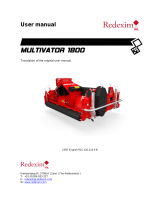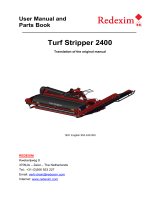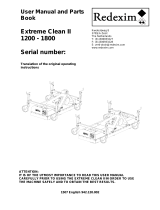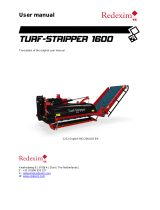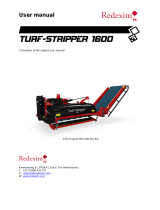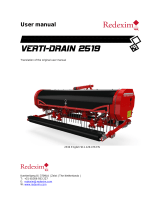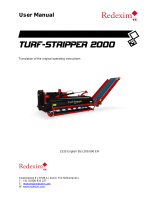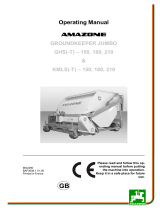Page is loading ...

NOTE:
IN ORDER TO ENSURE THE SAFE USE AND TO ACHIEVE THE
BEST PERFORMANCE, IT IS ESSENTIAL THAT THIS OPERATING
MANUAL IS CAREFULLY READ BEFORE THE TURF TIDY IS
USED.
0948 English 941.120.405
Operating and Parts
manual
Turf Tidy
Model 1310 & 1710
Serial number:
Translation of the original operating instructions

2
FOREWORD.
Congratulations on the purchase of your TURF TIDY. To ensure the safe and lasting
operations of this TURF TIFY you (and anyone using the machine) should read and
understand this users manual. A complete knowledge of the contents of the manual is
necessary in order to ensure the safe use of this machine.
The TURF TIDY is not an independently operating machine. It is the responsibility of the
user to use the correct tractor. The user will also need to check the tractor / TURF TIDY
combination on safety aspects, noise level, user instructions and risk analysis.
The TURF TIDY is intended exclusively for grass fields or areas on which grass can grow.
On the following page, we will begin with the safety instructions. Every user must be familiar
with these instructions and must follow them carefully. Below you will find a registration
card, which should be returned to us so that we are able to process any future claims.
In this manual, many instructions are given which are stated in a number sequence. The user
must follow the instructions according to this sequence. If the * appears this refers to
safety instructions. If the @ is used, this refers to a tip and/ or note.
All information and technical specifications provided at the moment that this
document is published are the most recent ones. Design specifications may be
changed without prior notice.
This document is a translation of the original operating instructions.
Upon request, the original operating instructions are available in Dutch.
GUARANTEE CONDITIONS
.
THIS TURF TIDY PRODUCT IS DELIVERED TO THE CUSTOMER ACCOMPANIED
BY A GUARANTEE AGAINST DEFECTS IN THE MATERIALS USED. THIS
GUARANTEE APPLIES FOR A PERIOD OF 12 MONTHS AS OF THE DATE OF
PURCHASE.
TURF TIDY GUARANTEES ARE SUBJECTED TO THE "GENERAL CONDITIONS
FOR SUPPLY OF PLANT AND MACHINERY FOR EXPORT, NUMBER 188", WHICH
ARE PUBLISHED UNDER THE AUSPICES OF THE UNITED NATIONS ECONOMIC
COMMISSION FOR EUROPE
.
REGISTRATION CARD.
For your own record, copy the information from the registration card to the table hereunder.
Serial number of machine
Name of your distributor
Date of purchase
Any remarks

3
SAFETY INSTRUCTIONS
.
1. Always use the TURF TIDY with the correct tractor as described in the
technical information
2. The user is responsible for a safe Tractor/TURF TIDY combination. The
combination must be tested for noise, safety, risk and easy usage. It is also
necessary to draw up user instructions.
3. Every TURF TIDY user must be fully informed of the information
contained in the user manual.
4. Inspect the ground where the TURF TIDY is to be applied. Remove loose
obstacles, avoid uneven ground.
5. Never step off the tractor if the engine is still running.
6. Ensure that other people are standing at least 4 mtr. (14' ) away from the
TURF TIDY.
7. Use appropriate clothing. Wear strong shoes with a steel inforced toe cap,
long trousers, tie up long hair. Do not have any loose pieces of clothing.
8. Never try to force the TURF TIDY, a situation which is visible in the
unstable behavior of the TURF TIDY.
9. Check the TURF TIDY once a week to ensure there are no loose screws or
nuts and bolts.
10. The TURF TIDY may never be used without protection covers and safety
stickers.
11. NEVER crawl underneath the TURF TIDY.
12. Always switch off the engine and uncouple the power take off, before
starting any maintenance, adjustment or repair. Also block the TURF TIDY
against sinking and block it against forward/backward movement or sliding.
13. Use only the original TURF TIDY spare parts in order to ensure the safe
operation of the machine.
14. Never use the TURF TIDY in the dark, in heavy rain, on frozen ground,
stormy conditions or on slopes greater than 20 degrees.
15. Before operating the machine, also read the instructions and the
maintenance information for the power take off. This component has its
own certification mark.
16. Maintain a log book of repairs.
17. If any modifications are carried out on the machine the CE certification
mark will be no longer valid. The User/Dealer himself must then have the
machine re-certified.

4
CONTENTS.
Paragraph
Description Page
Foreword 2
Guarantee conditions 2
Registration card 2
Safety instruction
3
1.0 Technical specification 5
2.0 First setup, lifting TURF TIDY from pallet 6
3.0 Preparing the Turf Tidy 7
3.1 The pulled version 7
3.2 The short-coupled-version 8
4.0 General controls 9
5.0 PTO 11
5.1 PTO length 11
6.0 Working depth adjustment 11
6.1 Adjusting the front roller 12
6.2 Adjusting the rear roller 13
6.3 Weight compensation springs 13
7.0 Ground speed/ Power requirements 13
8.0 General notes on using the Turf Tidy 14
9.0 Road transport of the Turf Tidy 15
10.0 Problem analysis 15
11.0 Maintenance 16
12.0 EU- Declaration 17
13.0 Technical issues 17
13.1 Belt tension adjustment 17
13.2 Repositioning the head 18
14.0 Options, Safety Notes 18
14.1 Scarifier blades 19
14.2 Flail blades 19
14.3 Brush kit 20
14.4 Castor wheel kit for head 20
14.5 Dual wheels for 1310 21
14.6 Short-coupled-kit 21

5
1.0 TECHNICAL SPECIFICATIONS.
Model: 1310
1710
Working width: 1300 mm (60”) 1700 mm (72”)
Tractor speed @ 540 rev’s at PTO
Sweeping
Scarifying
Flail mower
1-10 km/h (0.6- 6 mph)
1-5 km/h (0.6- 3 mph)
1-2 km/h (0.6- 1.5 mph)
1-10 km/h (0.6- 6 mph)
1-5 km/h (0.6- 3 mph)
1-2 km/h (0.6- 1.5 mph)
PTO speed: Up to 540 Up to 540 rpm
Weight: 890 Kg (1960 lbs) 990 Kg (2180 lbs)
Slit spacing side-to-side:
( as scarifier)
24 mm ( 0.95 “) 24 mm ( 0.95”)
Recommended min. tractor size:
As Sweeper:
As Scarifier:
As Flail mower:
20 HP
28HP
35 HP
25 HP
32 HP
40 HP
Tractor hydraulic requirements Single acting outlet
Maximum 175 bar (2500 psi)
Single acting outlet
Maximum 175 bar (2500 psi)
Tractor hitch Trailed ring and pin
Short coupled at 3-point bottom
arms
Trailed ring and pin
Hopper Capacity 1.8 cubic meter (63 cubic ft) 2.3 cubic meter ( 81 cubic ft)
Tipping height 1680 mm (67”) 1680 mm (67”)
Transmission oil SAE 90 SAE 90
Rear Tire Pressure 0.8- 1.8 bar (11- 25 psi) 0.8- 1.8 bar (11-25 psi)
Electrical power 12 Volt DC, 15 Amp 12 Volt DC, 15 Amp
Lubrication grease EP 2 EP 2
Standard items Set scarifier blades
PTO shaft
Product manual
Draw bar
Set scarifier blades
PTO shaft
Product manual
Draw bar
Shipping dimension 120 x 170 x 228 cm(LxWxH)
(48”x 68” x 92” )
120 x 207 x 228 cm (LxWxH)
(48”x 83” x 92” )

6
2.0 FIRST SETUP, LIFTING MACHINE FROM PALLET
.
The machine stands vertically up on the pallet. To remove the pallet and place the machine
horizontal on the ground, handle as follows (see fig.1)
Plac
e the machine with pallet on a hard leveled floor 11, fig 1.
1. Remove all separate packed components 12 –19 etc. from the pallet, the head and (inside)
the hopper.
2. Connect a cable or chain with a length of 2800 mm ( 112”) and a load capacity of 4000 Kg (
9000 lbs) with two well rated D shackles around the pivot shafts of the hopper 2, fig.1.
3. Connect the cable to a hoisting crane 1, fig.1., with a lift capacity of minimum 1750 Kg
(4000 lbs). A fork lift truck may be used as well, if the fork length and lift capacity do
match. Enter from side 11, fig.1., when using a lift truck.
• Ensure the fork lift capacity is enough at the lift point.
• Ensure that the string is securely tightened.
4. Carefully raise the machine with pallet attached.
• No bystanders allowed within a distance of 5 mtr (20’).
5. When the machine starts to tip at the pallet end, slowly and gently start dropping the
machine.
• Ensure the crane/ lift point can move with the machine when the machine tips. The
string should stay secured all the time.
6. Gently lower the machine, that tips around the pallet, till it is close to the ground.
7. Assemble both rear wheels 13, shafts 14, castor supports 12 and connector beam 15 .
8. Drop the Turf Tidy gently with the wheels on the ground.

7
9. Block the wheels from moving. Disconnect the cable.
10. Connect the cable at the pallet side of the Turf Tidy and raise the machine.
• Be sure the unit is well secured, so it doesn’t move when lifting
• The cable should be well secured to the chassis of the machine and lifting device.
11. Raise the Turf Tidy and remove the pallet by disassembling the fixing points 8.
12. Put the jack stand 16 on the Turf Tidy.
13. Lower the machine till it stands on the jack.
14. Next the machine can be prepared for the tractor, see chapter 2.1.
PS. If you are not sure how to assemble the parts, please study the spare part pages at
the end of this manual for a full understanding.
3.0 PREPARING THE TURF TIDY.
3.1 THE PULLED VERSION.
Both models are standard delivered as pulled versions.
Remove all straps that hold the machine together.
Start assembling the several items:
- Top cover and door of hopper. They are reversed (4 in Fig.1.) and bolted (5) on the
hopper. Remove them completely. Mount the smallest front one first. Add the pivots.
Mount the door to the pivots only. Align the cover and door before finally tightening
all bolts and nuts. Check whether the door pivots well.
- Add the PTO cover to the gearbox.
- The rear roller may need assembly
- The front roller with the two jacks has to be mounted to the head.
The Turf Tidy draw bar 1 can be fitted in two position, see Fig.2 and 3. This allows the
machine to cope with an upper and bottom tractor hook up point.
The draw bar plate 8 can be bolted on in four positions. Since it is bent, it can be set at two
different positions ( 8 and 9), above and under the main draw bar box section. Choose the
position at which the draw bar plate aligns the best with the tractor hook up. Tighten all bolts
carefully.

8
Connect the Turf-Tidy to the tractor.
With turnbuckles 10 we can adjust the machine height to the ground. The size A should be
805 mm (32”). When correctly adjusted, we will use the maximum stroke of the head.
For PTO information, see Chapter 5.
Next the hydraulic hose should be connected to a (single) acting outlet of the tractor. Use a
correct quick connector 3.
* A flow reducer is built in right after the quick connector. That may never be taken
out, since the drop speed of the head and hopper would become unsafe high and
damage may appear.
Standard the Turf Tidy is equipped with an electrically operated switch valve 11. This valve
will switch the single input from the head to the hopper, when activated.
When 12 Volt DC is applied to the solenoid, the valve switches. It may take up to 12 Amp.
An electrical switch 7 is standard built into the cable. The connector 4 is not standard
delivered all the times, as we have many different systems.
However we advise to connect one of the wires e.g. 5 to the mass and the other one 6 to the
Brake Light connector point at the tractor ( used for trailers lightening). So when we use the
brake, the switch valve switches, when switch 7 is on.
* This means that when we tip the hopper, the tractor driver has to put the brake on,
which is what we want during emptying the hopper.
In case such a brake light connection point is not available, a continuous 12Volt point may be
connected to the wire 6. (5 has to be on the mass). By using the switch 7, the driver can swap
between the two hydraulic systems.
• Be sure a fuse is built in the 12 Volt supply point.
• Guide the hydraulic hose and electric cable nicely, so they aren’t caught.
@ If the wire is too short, it may be extended, so it can be positioned at the correct place for
the driver.
@ It doesn’t make a different which wire is 12 Volt and which one is connected to the mass.

9
3.2 THE SHORT- COUPLED- VERSION.
The model 1310 can be used as a short coupled version as well, which means that the
machine is connected to the two bottom arms 12 of the tractor’s 3-point linkage, see Fig.4.
Read Chapter 3.1. carefully as well, regarding all comments and notes for the hydraulics and
electrical connections.
Our short coupled version works different than other comparable machines on the market.
The 3-point linkage has to be set at a certain height which should be kept all the time. It
needs to be set at a height till A= 805 mm ( 32”). The head is raised and lowered as with the
pulled version. The great advantage of this system is that no matter how full the hopper is
loaded, the weight on the head stays always the same, since the hopper weight is carried by
the 3-point linkage.
At the moment the machine is transformed to a short-coupled-version, the connecting beam
13 between the rear wheel castor supports 14 has to be removed. This enables the rear wheels
to turn when the machine swings.
• When the machine is rebuilt to a pulled version, the connecting beam 13 has to be
mounted right away.
• Be careful driving the short coupled version. Turning the tractor means that the
machines swings away.
• Be carefull with overloading the main chassis of the Turf-Tidy when short coupled.
• Block the side movement of the bottom arms of the 3-point linkage.
• Do not use the 1710 as a short-coupled-version.
• The maximum transport speed is to be reduced to 20 km/h (14 mph).
@ See the part pages for information on the part number of the kit.

10
4.0 GENERAL CONTROLS.
As the machine with tractor is ready for use, an overview of key components on the Turf-
Tidy are explained, as follows, see Fig.5 as well:
1. Top door hopper.
2. Opening for air to escape.
3. Window for checking filling rate op hopper.
4. Independent moving head, sealed to the hopper.
5. Lock nuts for access door head.
6. Jack handle for adjusting working depth head.
7. Locking plate jack handle. Lift for unlocking.
8. Electrical switch for switching hydraulic valve from head to hopper or visa versa.
9. Electrical connector to tractor ( not always included, since standards are different)
10. Hydraulic quick connector and flow reducer. Use your own connector, DO NOT
REMOVE THE FLOW REDUCER.
11. Standard PTO shaft pulled version. Optional: Wide angle version when many (tight)
curves are made during the work.
12. Draw bar connecting plate, bolted on for easy adjustments.
13. Hole to connect safety D-shackle located on top of gearbox.
• Secure head every time maintenance and/ or repair is done with the head up.
14. Turnbuckle to match machine to tractor.
15. Standard front roller for depth adjustment of the head.
16. Spring for controlling ground pressure of the head. Is adjustable via chain.

11
17. Safety decal 911.280.402: Keep distance to the machine, switch off engine and
lock machine when maintaining or adjusting and be aware of moving parts.
18. Lift cable.
19. Shoe. Should be close to the ground all the time. So adjust them when height is
altered.
20. Nut holding the shoes.
21. Main V-belt drive cover.
22. Rear roller for anti scalping. Should be approximately 10 mm (3/8”) above the
ground
23. Manual box with operating manual and decal RA: Read manual first.
24. Top guide rod head. Is adjustable. See manual for further instructions, when
necessary.
25. Access door head. SHOULD ALWAYS BE ON AND SECURED.
26. Bottom guide rod head. Is adjustable. See manual for further instruction.
27. Rear wheel.
28. Safety decal: Keep fingers away.
• All safety decals and protection covers should be on the machines all time. If
damaged or lost, replace them immediately.
•
Never creep under the tipped hopper.
• When tipping or dropping the hopper, everyone should stand clear 4 mtr (16’) from
the machine.
• Do not stand between the tractor and the machine
• When adjustments are needed, switch the engine off.
5.0 PTO.
The PTO is a very important item. It drives the machine from the tractor and ensures the safe
operation when correctly maintained and installed. The PTO shaft has its own CE
certification. Read the PTO shaft manual, which is connected to the shaft itself.
Some important notes on the PTO drive, see Fig.2,3,4.:
1. It is very important that the joint angles 21 and 22 are the same. If the difference is more
than 10 degrees, the rotational speed to the gearbox 23 starts to be irregular. This will
create vibrations in the drive line towards the rotors and will cause damages to the
machine.
2.
The difference under 1 arises e.g. when we make (tight) turns with the machine when
used as a sweeper. That will create damages to the machine in the end. If people want to
make (tight) turns during work a wide angle PTO is necessary.
3.
Under normal conditions ( making straight passes) we will not create vibrations on the
drive line if the machine is well set, see chapter 3.
• The unit may not be used when the PTO cover is damaged. Replace immediately.
•
Be sure the PTO protection cover is assembled and undamaged too
•
For maintenance, see the instructions on the PTO shaft.
•
The maximum speed of the PTO is 540 rpm’s

12
5.1 PTO LENGTH.
The length of the PTO is very important. When too long, the transmission of the tractor
and/or TURF TIDY may be damaged. When the overlap length of the tubes drops under 300
mm (12") anytime, the PTO may get damaged as well.
The size B, fig.2,3,4., should be 100 mm (4”) minimum to allow the PTO tubes to move
freely all the time. If this distance B is less, the PTO should be cut till size B is achieved.
* the length changes when the head is raised or when another tractor is used or when
(tight) turn are being made. Check size B for the worst case.
6.0 WORKING DEPTH ADJUSTMENT.
The position of the head to the ground can be adjusted. As a scarifier, the knives should go in
the ground. As a sweeper or flail mower, the head should work at a higher position. That can
all be achieved.
6.1 ADJUSTING THE FRONT ROLLER.
The head is mainly supported by the front roller 5, see fig.6. The front roller should support
the head all the time. The rear roller should be B= 10 mm (5/8”) from the ground all the time,
which will prevent the head from scalping the turf.
With flail mowing or sweeping, the front roller can be exchanged with castor wheels, see the
options in the manual. With the castor wheels, we can make turns with the unit as well, which
is barely possible with the standard front roller mounted on.
To adjust the front roller, work as follows see fig.6.:
• Be sure the engine is shut down
• The head should be raised and secured with D shackle 13 (see fig 5.)
• Don’t creep under the machine.
• Be sure the machine is blocked.
1. Use both turn buckles 3 to adjust the front roller position. The turn buckles are secured
with lock 4.
@ Do not adjust one side more than two turns, compensate the other side first.
2. When the correct depth A is achieved, continue to work with the machine.

13
6.2
ADJUSTING THE REAR ROLLER.
As mentioned in 5.1, the rear roller 22 (Fig 5.) should be close to the ground to prevent
scalping of the turf when the machine is used as a scarifier or sweeper.
To adjust the rear roller, work as follows see fig.6.:
• Be sure the engine is shut off
• The head should be raised and secured with D- shackle 13 (see fig.5.)
• Don’t creep under the machine.
• Be sure the machine is blocked.
Adjusting the rear roller goes as follows, see fig 6.:
1. Slacken nut 12.
2. Move the roller up or down by hand.
3. When the desired position is achieved, tighten nuts 12 at both sides.
@ Be sure both sides are set the same.
6.3 WEIGHT COMPENSATION SPRINGS.
The roller can support the head all the time.
However when small turns are made with the machine during work, the weight from the head
has to be reduced. If not the head is pushed sideward and damages will appear to the head
and the lift mechanism.
The spring load 2 (Fig.6.) can be adjusted by shortening or lengthening the chain 1. If the
spring load is increased, (tighter) turns are easier to make.
The spring load 2 can only be changed when the head is fully up and secured. Choose the
next chain shackle (adjust both springs evenly). The spring load also retracts the hydraulic
cylinder when the unit is lowered and the valve is opened for a little longer.

14
7.0 GROUND SPEED / POWER REQUIREMENTS.
.
The ground speed is directly related to the power needed for the job. The more power, the
lower the forward speed.
If we are transmitting too much power, the following may happen:
- the V belts may start to slip.
- The blades are swinging more around the pins, causing excessive wear on pins and holes
- The blades are wearing quicker and in a wrong direction.
- Due to the swinging of the blades, the secure clips on the pins may break and blades
coming off the rotor.
The machine is heavily built, so you wouldn’t notice an overload quickly. It is however
important to judge the power requirements. Take the following notes in considerations:
When used as a scarifier:
• what is the working depth. The deeper, the more power.
• What is the toughness of the material we are cutting. The tougher, the more power.
• What is the ground speed. The more speed, the more load on a blade.
• Condition of the blades. The more worn, the more the power.
- When used as a sweeper:
• More material to collect asks for more power.
• The heavier the material, the more power.
• Undulations and other obstacles that are hit by the brushes, will increase the power
• The faster we go, the more power is needed.
- When used as a flail mower:
• The tougher the grass, the more power is required.
• Thicker/more grass increases the load on the blades.
• The more speed, the more power is required.
• Worn blades will increase the power requirement dramatically.
The general ruling is that when the load on the blades increases, the ground speed has to be
reduced. See for guidelines the Technical Specs.
Some scarifier blades and the flail blades can pivot around the pins. The centrifugal force has
to keep the blades at their position. When the load increases, the blades are swinging around
the pins, which will wear the pins and loosen the secure clips. The ground speed has to be
reduced.
Since the centrifugal force is directly related to the rpm’s of the rotor, it is recommended to
increase the rev’s on the rotor / PTO, which will increase the load resistance on the rotatable
blades. We can go up to 750 rpm on the PTO in rough conditions.
When fixed ( scarifier) blades are used, the maximum rpm on the PTO should be 540 rpm.
For the brushes 300-400 rpm’s on the PTO will do.

15
8.0 GENERAL NOTES ON USING THE TURF TIDY
.
The TURF TIDY can only be used when the circumstances are right. First some items
regarding the working area:
1. Are there any loose objects on the field. If so, these must be removed first.
2. Are there any slopes? The maximum slope for the TURF TIDY is 20 degrees. Always
operate the TURF TIDY from the top to the bottom of a slope.
3. Is there any danger of flying objects such as golf balls, which could distract the attention
of the driver? If so, the Turf Tidy can not be used at that moment.
4. Is there any danger of subsidence of land/ mud slides? If so, the Turf Tidy cannot be
operated on the field at that moment.
5. Is the ground frozen or very wet? Postpone the operation till the circumstances are better.
6. If the ground is very compacted, adjust forward speed and depth of working.
Next some items related to the TURF TIDY:
1. Do not overload the Turf Tidy, see chapter 6.0
2.
Do not make ( tight) turns. If you need to do so, check the weight compensation (chapter
5.3) and the PTO ( chapter 4.0).
3.
Do not allow anybody close to the machine.
4.
Tipping the hopper may only be done on a hard leveled ground.
5.
Never drive with the Turf Tidy when the hopper isn’t down.
6.
Do not overload the hopper. It will not tip and emptying by hand is necessary
9.0 ROAD TRANSPORTATION OF TURF TIDY
.
The user is responsible for the transport of the TURF TIDY behind the tractor along the
public streets. Check on the national legislation’s. Across open ground a maximum speed of
25 km/h (16 mph) applies. In view of the weight of the TURF TIDY, a higher speed could be
dangerous for the driver and bystanders. The machine could also suffer damage due to jolt
which can occur with higher speeds.

16
10.0 PROBLEM ANALYSIS
.
Machine vibrates
Missing blades/ brushes
Rotor out of balance
PTO shaft damaged
Drive line vibrates
Ground conditions
Are the brushes damaged
Damage to machine
Rotor bearings failed
Overspeeding
Check and replace
Check for damages and or
material wrapped around
Check carefully
Adjust working conditions
Use wide angle PTO
Check and replace.
Check items
Check and replace
Check PTO rpm’s
Blades/ pins/ secure clips
bending/ breaking
Overload
Field obstacle
Wrong type blade
Check ground conditions and
Adjust working parameters
Rough uneven grounds
Remove them first
Decrease PTO rpm’s
Change blades
Change to other type of blade
Adjust working depth
Check rpm’s PTO
No clean surface Ground very wet
Not enough draft
If possible, postpone job
Reduce ground speed
Increase PTO speed
Add brushes to main rotor
Increase PTO speed
Unstable behavior head
Too much weight compensation
Rough ground
Rotors out of balance
Reduce weight compensation
Use front roller, not wheels
See “machine vibrates”
Damage to the turf
Bad turf conditions
Blunt blades
Reduce working depth
Reduce forward speed
Use other blades
Replace/ swap blades

17
11.0 MAINTENANCE.
Pre-Delivery-Inspection
Grease rotor bearings
Check bolts/ nuts
Connect the unit to a tractor
Run unit for 5 min
Check oil level gearbox
4 shots each EP 2
See instructions in this
manual
Look and listen
After first 20 hours
(new or repaired)
Grease PTO shaft bearings
Grease rotor bearings
Check bolts/nuts
Check oil level gearbox
Inspect blades/ brushes
Inspect the overall machine
2 shots each EP 2
4 shots each EP 2
After every 100 hours Grease PTO shaft bearings
Grease rotor and rollers
bearings
Check bolts/nuts
Check oil level gearbox
Inspect blades/ brushes
Inspect the machine
Clean head and hopper inside
2 shots each EP 2
4 shots each EP 2
After every 500 hours Change gearbox oil
Grease and adjust wheel
bearingsCheck all bolts/ nuts
Check components for wear
Use SAE EP 90
12.0 EU-Declaration
.
We, Redexim Utrechtseweg 127 3702 AC Zeist Holland, hereby declare fully on our
authority that the product:
TURF TIDY 1310/ 1710, WITH MACHINE NUMBER AS INDICATED ON THE
MACHINE AND MENTIONED IN THIS MANUAL,
to which this declaration relates is according to the stipulation of the 2006/42/EC
directive for machines.
Zeist, 01/10/09
A.C. Bos
Manager Operations & Logistics
Redexim Holland

18
13.0 TECHNICAL ISSUES.
13.1 BELT TENSION ADJUSTMENT.
The main rotor is driven directly from the gearbox via 2 V-belts at the right side of the head.
At the left side, the V belt drive for the second rotor is taken from the main rotor.
Both belts are tensioned via an identical idler.
Tensioning the belts goes as follows, see Fig 7:
1. Switch off engine and lower the head on the ground.
2. Remove the protection cover 7. NOTE. The cover at the left side ( second rotor) can
only be removed when the head is fully down or better the main frame is fully up.
Disassemble the cable 18 and spring 16 (fig 5), and move the main frame up via the
support jack. Next the cover can be removed.
3. Check the tension. When a force of 150 N (33 lbs) is applied per belt, A should be 5-
10 mm ( ¼”- ½”).
4. If the tension isn’t correct, slacken nut 4 and push the idler 5 down by hand. The
idler will slide into its support plate 6. Tighten nut 4 and check the tension as
mentioned under 3).

19
5. Rotate the pulleys by hand and check the alignment. If okay, assemble the protection
cover.
@ When the V-belts are worn, adjusting the tension wouldn’t help preventing the slip.
Replace the V-belts.
@ Do not overtighten the belts. Damage to the machine may appear.
13.2 REPOSITIONING THE HEAD.
The head is positioned in the main frame with two top guide rods 3 ( see Fig.8.) and two
bottom guide rods 7. All these rods have pivot eyes at their ends, which makes the head
extremely flexible.
Since the head is so flexible, the head should have a certain distance to the hopper. This
distance can be adjusted, within certain limits, as follows:
1. When the head is fully down, the rubber seal 2 ( Fig.8.) may be against the hopper
edge 1. Adjust the length of top guide rod 3 to accomplish this. Adjust both sides the
same all the time. Next lock the rod with the two nuts 6.
2. When the head is fully raised, the rear roller 4 ( in highest position) may not hit the
hopper 5. A clearance of 5 mm ( 5/16”) is required. This should be adjusted with the
bottom guide rod 7. Adjust both sides evenly and lock it with nuts 6.
After the adjustment has been carried out, check whether the head does not hit the main
frame at any place during its full stroke. If so, readjust the rods.
14.0 OPTIONS, SAFETY NOTES.
The main rotor can be equipped with several attachments, which are explained later.
Maintaining and exchanging items on the main and second rotor is done via the access door
25 of the head ( see Fig. 5). Some important notes:
• The machine may never run without the access door correctly fitted.
• When repair, maintenance is planned, the head should be firm on the ground, or
secured with D- shackle 13 ( Fig 5).
• Be sure that the secure spring pins 1 ( Fig .9.) are correctly assembled.
• If the lock pin 3 or the secure spring pin 1 is worn, they should be replaced
immediately.
• Check that the brushes ( when mounted) are tightly fitted.

20
14.1 SCARIFYING BLADES.
The Turf Tidy is standard delivered with fixed scarifier blades 2 ( see Fig. 9.).
When hard objects are to be expected, reduce the rpm’s of the PTO till about 300 rpm’s. The
blades may break and dangerous circumstances may appear.
Do not replace any worn blades for new ones. Always replace the full set, because the
balance may be jeopardized.
If not all material is picked up, two brush elements can be assembled. Assemble them in the
position closest to the rotor center (hole 13). These two brushes should always be opposite
each other on the rotor.
If you want to enlarge the distance between the slits, remove 4 rows of blades, out of the
standard 8.
14.2 FLAIL BLADES.
Two flail blades are available, see fig. 9.:
1. Back to back flail blades, # 4
2. Plain flail blades # 9.
Both blades are to be assembled into hole 10.
For part numbers of the blades and the kits, see the attached spare part pages.
It is very important to read and understand chapter 6.0, which explains centrifugal forces,
wear, load on the blades and ground speed.
/

